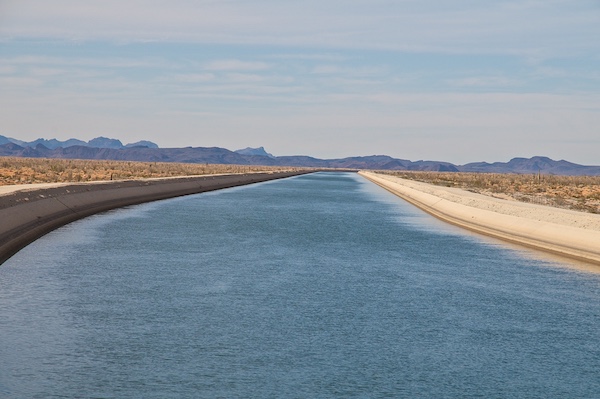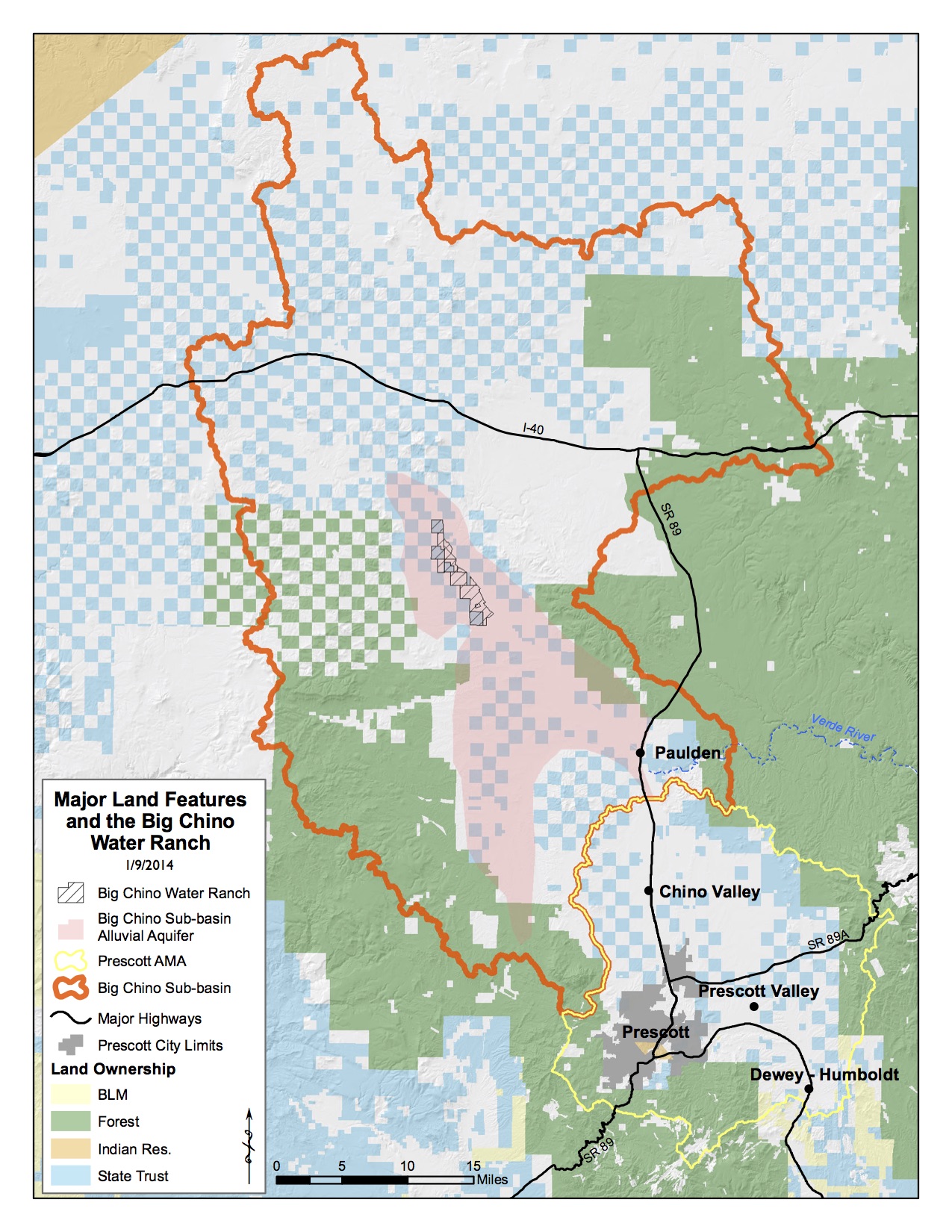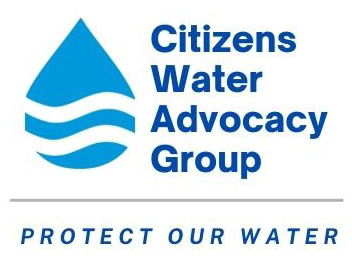The 1980 Arizona Groundwater Management Act (AGMA) established Active Management Areas (AMAs) with the general goal of progressively limiting groundwater pumping. Seeking to extend their water supply, some central Arizona water providers soon sought to import water from neighboring rural areas, spurring additional corrective legislation. In 1991, Arizona enacted the Groundwater Transportation Act to prohibit transfers of groundwater from other basins into AMAs. The law included two exceptions for the Big Chino Sub-basin: “Exemption Groundwater” specifically for the City of Prescott, and “Historically Irrigated Acreage Groundwater” (HIA) for cities in the Prescott AMA (PrAMA). Despite the importance of a flowing Verde River, the Arizona legislature authorized transfers of water out of the Big Chino. Prescott and Prescott Valley formed a partnership in 2004 to construct a pipeline, sharing the water and the costs. Prescott has 54% of the project and Prescott Valley has the remaining 46%. Designed for a maximum capacity of 12,000 afy, the pipeline would transport the water into their municipal systems. Dissatisfied with the ruling, the hearing plaintiffs asked the Maricopa County Superior Court to declare that the statute authorizing Prescott to transport water out of the Big Chino, ARS 45-555E, was “special legislation” that violates the Arizona Constitution. The judge quickly ruled against plaintiffs, basically referring the case to the State Court of Appeals. Salt River Project (SRP), Prescott, and Prescott Valley agreed to a Monitoring and Modeling plan costing $5 million over 8 years to study Big Chino hydrology and create a new groundwater model. The plan calls for new monitoring wells, weather stations, flow measurements of ephemeral streams, and geo-physical surveys. The new monitoring data feeds into the new groundwater model. The goal of the plan is to determine if groundwater pumping will diminish the base flow of the Verde, to establish a means of advance warning for impending base flow changes, and to project the location, timing, and quantity of mitigation water needed. Progress reports are released annually: 2014, 2015, 2016, 2017, 2018.
Legal Basis for Groundwater Transportation
The “Exemption Groundwater” provision permitted Prescott to import up to 14,000 acre-feet/year (afy) from the Big Chino as compensation for relinquishing 7,127 afy of Central Arizona Project water (sold to Scottsdale for $3.5M, finalized in 1994) and other assistance in settling Indian water rights claims. Subsequent legal actions in 2010 decreased the allowed transfer to 8,068 afy.
Historically irrigated acres (HIA) are agricultural lands irrigated between January 1, 1975 and January 1, 1990. ADWR reported 3,582 acres of HIA lands in the Big Chino. State law permits exporting 3 afy for each acre of HIA lands that are permanently retired from irrigation, therefore up to approximately 10,746 afy of HIA Groundwater can be legally exported to the PrAMA for municipal uses. The Big Chino Water Ranch (BCWR) contains approximately 1256 acres of HIA lands, which combined with other holdings, qualifies Prescott for 3,483 afy of HIA water. In 2009 Chino Valley reported holding rights to approximately 400 afy of HIA water. The remaining HIA groundwater is temporarily unclaimed.
Updated Dec 19, 2018
Prescott’s Interest in Big Chino Water

In 1983, Prescott was granted 7,127 afy of Central Arizona Project water. After determining it was too expensive to pump the water uphill from the Phoenix canal, Prescott negotiated an agreement permitting Salt River Project (SRP) to withdraw Prescott’s CAP allocation in Phoenix in trade for allowing Prescott to withdraw an equivalent SRP allotment from the Verde River (SRP holds high priority water rights to the base and flood flow of the Verde River). A proposed diversion point in Clarkdale met environmental opposition and high costs.
Updated Dec 19, 2018
Location of Big Chino Water Ranch

Prescott next investigated several locations in the Big Chino for a well field. The city purchased the Dugan property and well, located in Paulden near Hwy 89. A 1989 well test found that the aquifer was extremely productive, but plans to pump this location were set aside due to concerns that pumping so close to Verde Springs would quickly diminish flow. The City also owns the Weber well near Sullivan Lake.
In 2004 Prescott purchased 4582 acres of the JWK ranch, including 1256 acres of previously irrigated land, renaming it the Big Chino Water Ranch (BCWR). The ranch is located about 15 miles NW of Paulden in the upper Big Chino Valley, a location chosen to moderate and delay the effects of groundwater pumping on Verde Springs.
Updated Dec 19, 2018
Big Chino Water Ranch & Pipeline Controversy
The water export plan aroused vigorous opposition from Paulden residents concerned about the impact on domestic wells, and from local citizens, SRP, Sierra Club, and the Center for Biological Diversity (CBD), all determined to protect the base flow of the upper Verde River. The US Fish and Wildlife Service (USFWS) expressed concerns that the pipeline would diminish the base flow of the upper Verde and harm endangered species, then suggested that Prescott begin negotiations to develop a Habitat Conservation Plan designed to mitigate any damage to protected wildlife. Prescott refused to work with the USFWS. CBD issued a letter of intent to sue under the Endangered Species Act if Prescott began construction. In October 2007, Prescott applied to ADWR to add the Big Chino water to their Certificate of Assured Water Supply (CAWS). The request was provisionally granted with modifications in November 2008, but a record number of public objections were filed with ADWR, leading to an 8-day judicial hearing conducted by the Office of Administrative Hearings. Although the purpose of the hearing was narrowly restricted to determining if existing ADWR rules were properly followed, the hearings generated a lengthy written record covering all the issues. A decision in favor of ADWR and Prescott was issued in October 2009. The Director of ADWR issued a modified Certificate of Assured Water Supply for Prescott in November 2009, permitting Prescott to transport 8,067 acre-feet/year (afy) from the Big Chino.
In October 2007, Prescott applied to ADWR to add the Big Chino water to their Certificate of Assured Water Supply (CAWS). The request was provisionally granted with modifications in November 2008, but a record number of public objections were filed with ADWR, leading to an 8-day judicial hearing conducted by the Office of Administrative Hearings. Although the purpose of the hearing was narrowly restricted to determining if existing ADWR rules were properly followed, the hearings generated a lengthy written record covering all the issues. A decision in favor of ADWR and Prescott was issued in October 2009. The Director of ADWR issued a modified Certificate of Assured Water Supply for Prescott in November 2009, permitting Prescott to transport 8,067 acre-feet/year (afy) from the Big Chino.
Updated Dec 19, 2018
Litigation and Negotiated Settlement
SRP, Prescott, and Prescott Valley announced a negotiated settlement of the litigation in February 2010. In the “Statement of Principles,” a roadmap for settlement, the parties agreed to abandonment of litigation, an expanded monitoring and groundwater modeling effort, and Prescott agreed to mitigate losses of Verde River base flow caused by the pipeline, plus other points. Subsequently, ARS 45-555E was amended by the legislature to comply with the Arizona Constitution.
Prescott now has legal authority to export from the Big Chino 8,067 acre-feet/year (afy) plus approximately 3,483 afy of HIA water for a total of 11,550 afy.
Updated Dec 19, 2018
Monitoring and Modeling Plan
Additional information including contracts and interim reports are available on the City of Prescott website.
Updated Dec 19, 2018
Groundwater Export to Prescott
Two alternative diversion points on the upper Verde were the subject of a 1990 Biological Opinion by the US Fish and Wildlife Service (USFWS) evaluating the effects of the diversion on an ESA listed native fish, the spikedace. The report found that the exchange would “severely reduce or eliminate the spikedace population.” Plans to divert river flow were abandoned in favor of pumping groundwater from the Big Chino.
